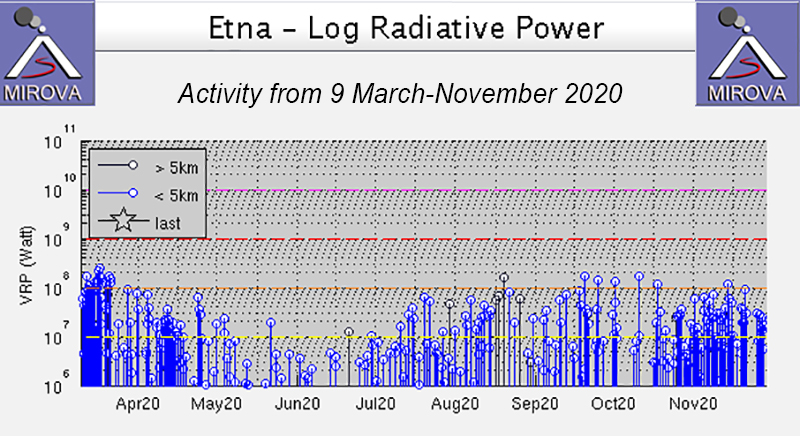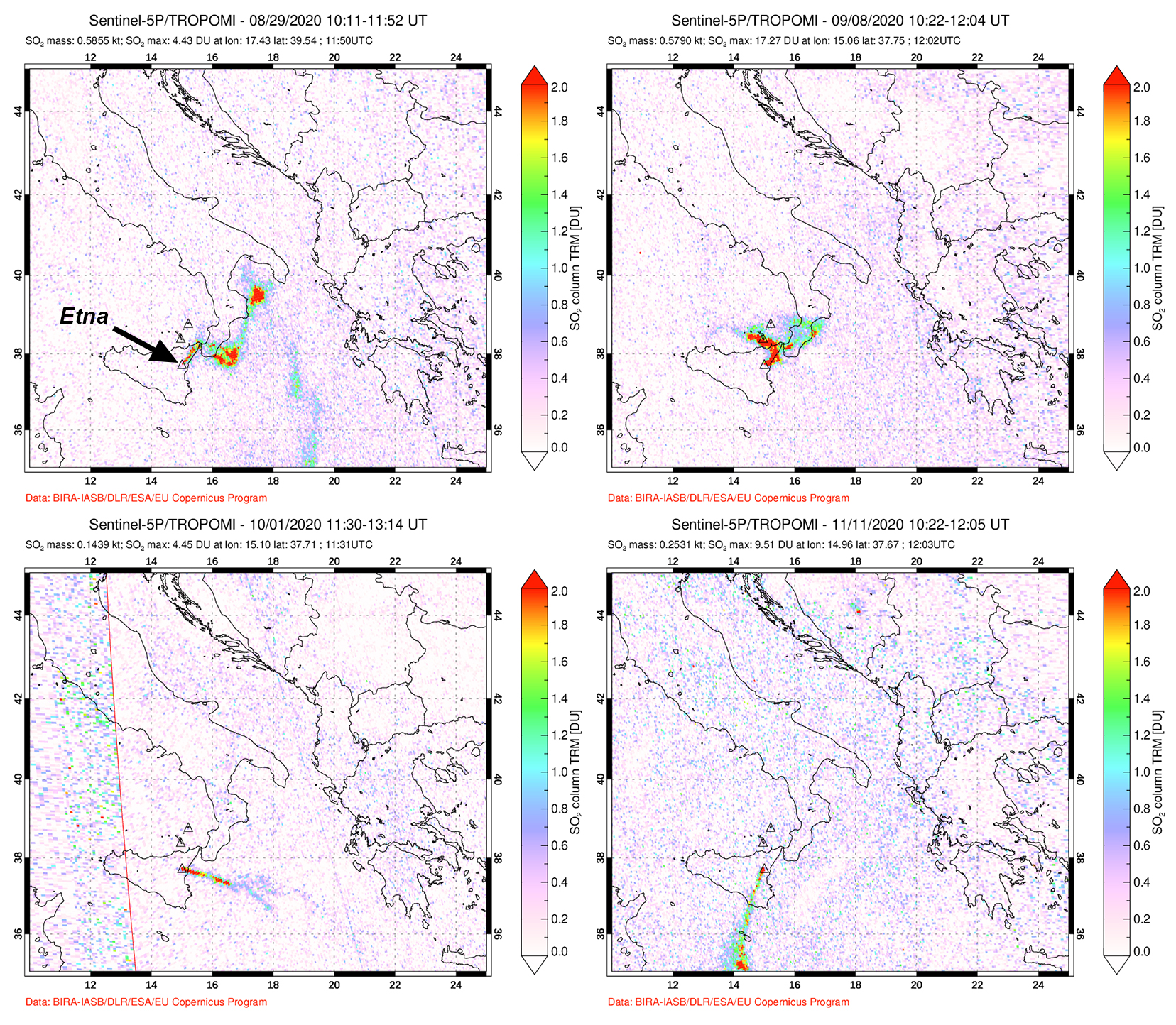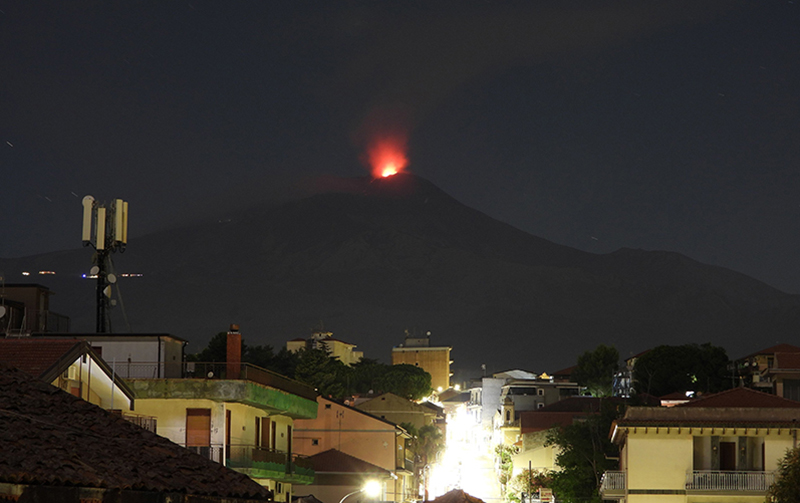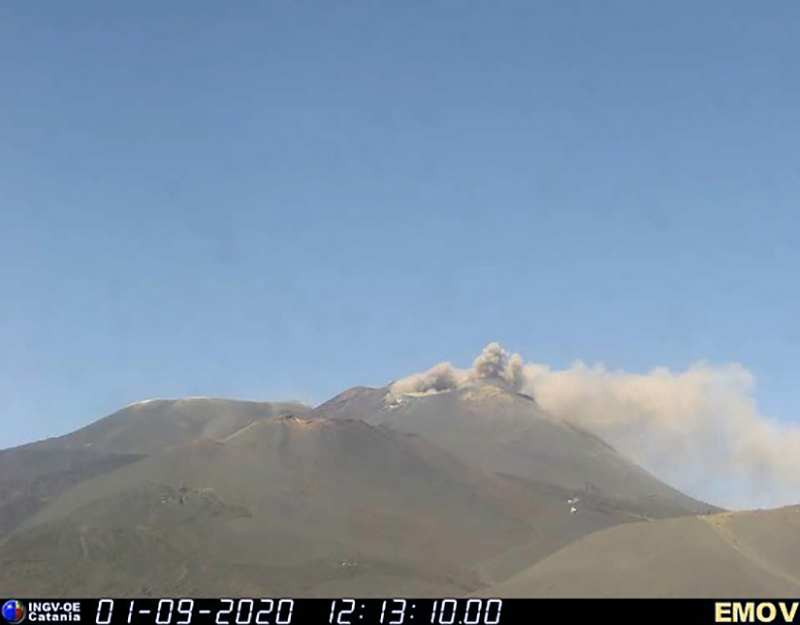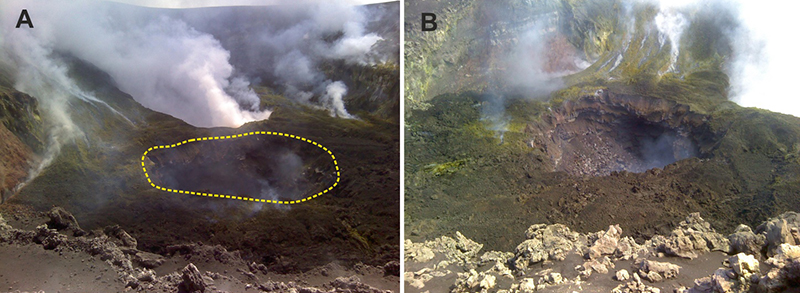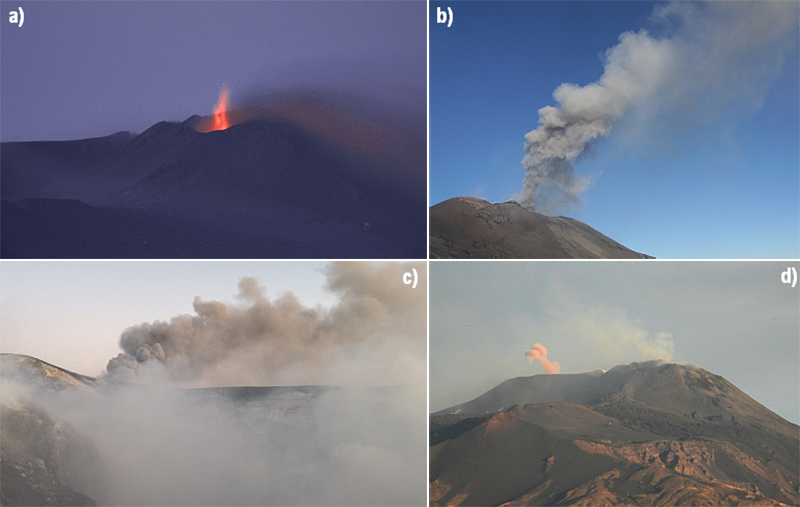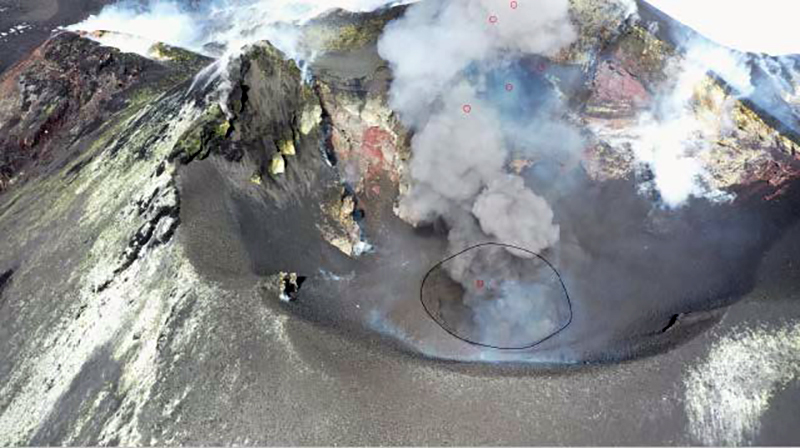Report on Etna (Italy) — December 2020
Bulletin of the Global Volcanism Network, vol. 45, no. 12 (December 2020)
Managing Editor: Edward Venzke.
Edited by Kadie L. Bennis.
Etna (Italy) Strombolian explosions and ash plumes persist from multiple craters during August-November 2020
Please cite this report as:
Global Volcanism Program, 2020. Report on Etna (Italy) (Bennis, K.L., and Venzke, E., eds.). Bulletin of the Global Volcanism Network, 45:12. Smithsonian Institution. https://doi.org/10.5479/si.GVP.BGVN202012-211060
Etna
Italy
37.748°N, 14.999°E; summit elev. 3357 m
All times are local (unless otherwise noted)
Etna, on the island of Sicily, Italy, and has had documented eruptions dating back 3,500 years. Its most recent eruptive period began in September 2013 and has continued through November 2020, characterized by frequent Strombolian explosions, effusive activity, and ash plumes. Activity has commonly originated from the summit areas, including the Northeast Crater (NEC), the Voragine-Bocca Nuova (or Central) complex (VOR-BN), the Southeast Crater (SEC, formed in 1978), and the New Southeast Crater (NSEC, formed in 2011). The newest crater, referred to as the "cono della sella" (saddle cone), emerged during early 2017 in the area between SEC and NSEC. This report from August through November 2020 updates activity consisting of frequent Strombolian explosions, ash plumes, summit crater incandescence, degassing, and some ashfall based on information primarily from weekly reports by the Osservatorio Etneo (OE), part of the Catania Branch of Italy's Istituo Nazionale di Geofisica e Vulcanologica (INGV).
Summary of activity during August-November 2020. Intra-crater Strombolian explosions that varied in frequency and intensity throughout the reporting period, and the accompanying ash emissions that rose to a maximum altitude of 4.5 km, primarily originated from the Northeast Crater (NEC), the New Southeast Crater (NSEC), and intermittently from the Voragine Crater (VOR). Degassing of variable intensity typically occurred at the VOR and the Bocca Nuova (BN) Crater. At night, occasional summit crater incandescence was visible in webcam images, accompanied by explosions and gas-and-ash emissions. On 14 August strong Strombolian explosions produced an ash plume that rose to 4.5 km altitude and drifted SE, resulting in ashfall between Pedara, Trecastagni, and Viagrande. INGV reported that the central pit crater at the bottom of BN continued to widen, and on 9 September scientists observed that a new pit crater had formed NW of the central depression and was widening due to crater wall collapses. During late October to 1 November, INGV reported that small lava flows originated from scoria cones in the NEC and were visible from the edge of the crater but did not spill over.
MIROVA (Middle InfraRed Observation of Volcanic Activity) analysis of MODIS satellite data shows frequent thermal activity of varying strength throughout the reporting period (figure 308). In late October, the frequency of the thermal anomalies increased, and continued through November. According to the MODVOLC thermal algorithm, a total of 31 alerts were detected in the summit craters during August through November; thermal anomalies were reported for five days in August, four days in September, four days in October, and eight days in November. Frequent Strombolian activity contributed to distinct SO2 plumes that drifted in multiple directions (figure 309).
Activity during August-September 2020. During August, INGV reported intra-crater Strombolian explosions in the NEC, VOR, and NSEC (including the cono della sella) craters, which produced discontinuous ash emissions rising above each crater (figure 310). Gas-and-steam emissions were the dominant activity in the BN crater. INGV noted that the central pit crater on the floor of BN had been gradually widening since April. On 2 August a slight increase in explosivity resulted in minor ashfall in Trecastagni and Acicastello. Explosive activity occasionally ejected material above the crater rim up to several tens of meters. On the morning of 7 August incandescent Strombolian activity was visible in the NSEC (figure 311). During the evening of 10-11 August surveillance cameras showed the explosions ejecting incandescent material on the surrounding flanks. On 14 August intense Strombolian activity in the saddle cone of the NSEC produced an ash plume that rose to 4-4.5 km altitude and drifted SE, resulting in ashfall between Pedara, Trecastagni, and Viagrande. By the evening activity had sharply declined, according to a VONA (Volcano Observatory Notice for Aviation) report, though sporadic ash emissions continued. A new series of ash emissions associated with explosions of varying intensity began on 15 August in the NSEC. A resulting ash plume rose to 4-4.5 km altitude and drifted ESE. On 17 August gas-and-steam emissions were seen rising above the VOR crater, accompanied by persistent Strombolian explosions. Between the afternoon and early morning of 20-21 August surveillance cameras showed an increased intensity and frequency of ash emissions above the NSEC and NEC that rose to 4-4.5 km altitude and drifted SSE. INGV-OE scientists reported minor ashfall in Trecastagni, Viagrande, and Catania. During 24-30 August ground observers reported that the intra-crater explosions in the NEC originated from two explosive vents; the BN crater exhibited gas-and-steam emissions from the central pit crater, which continued to widen. During 25-26 August explosive activity increased at the NSEC with ash emissions rising to 4.5 km and drifting SSE, which resulted in modest ashfall in Catania, Viagrande, and Trecastagni; by morning, the volume of ash emissions had decreased, though explosions persisted. During 28-29 August discontinuous and modest ash emissions originating from the NSEC rose 4.5 km altitude drifting E and ENE but did not result in ashfall. Emissions had stopped by 1747 on 29 August, though intense gas-and-steam emissions continued, occasionally accompanied by mild explosive activity (figure 312).
Strombolian activity of varying intensity continued in the NSEC and NEC during September, producing sporadic ash emissions (figure 313). The BN and VOR craters were characterized by gas-and-steam emissions. Explosions in the NSEC ejected coarse pyroclastic material above the crater rim several tens of meters, some of which were deposited on the S flank, and accompanied by sporadic ash emissions; these explosions continued to widen the depression in the saddle cone of the NSEC. Intermittent nighttime crater incandescence was observed in the NSEC. Sporadic and weak ash emissions were observed in the VOR. On 9 September INGV scientists reported intense degassing from the center pit crater in the BN. To the NW of this center depression, a new pit crater had formed and began to widen due to the collapse of the crater walls (figure 314). On 26 September explosions in the NSEC produced an ash plume that rose to 4 km altitude and drifted E, though no ashfall was reported.
Activity during October-November 2020. Similar variable Strombolian activity continued into October in the NSEC (cono della sella) and NEC; isolated and weak ash emissions were visible in the VOR crater and gas-and-steam emissions continued in both the VOR and BN craters. On 1 October an increase in explosive activity in the NSEC occurred around 0800, which produced an ash plume rising to 4.5 km altitude, drifting E. Ash emissions on 3 October were mostly confined to the summit crater, but some drifted toward the Valle del Bove. On 7 October Strombolian explosions in the NSEC generated an ash plume that rose to 4.5 km altitude drifting E and ESE. INGV personnel reported ashfall as a result in the Citelli Refuge. On 9 October drone observations showed at least three active scoria cones on the floor of the NEC with diameters of 30-40 m and heights of 10 m; a fourth vent was later reported in November (figure 315). INGV reported that activity characterized by Strombolian explosions and spatter was fed by these vents, accompanied by intense intra-crater fumarolic activity.
During 12-18 October surveillance cameras captured incandescence in the NEC and pyroclastic material seen during more intense explosions. During the week of 19-25 October several thermal anomalies were detected on the NEC and BN crater floor. Particularly at night, thermal and surveillance cameras observed incandescent ejecta rising above the NSEC (figure 316). On 23 October a helicopter overflight along the W side of Etna showed continued explosions at the NSEC, which produced both ash emissions and incandescent shreds of lava. An associated ash plume rose to 4.5 km altitude and drifted SSE. Sporadic ash emissions were also observed in the BN crater (figure 316). During 26 October to 1 November occasional Strombolian activity resumed in the VOR which ejected material over the crater rim. The BN crater activity was characterized by small intra-crater collapses and consequent ash emissions. In the NEC, similar explosive activity persisted with the addition of small lava flows from the scoria cones, which were visible from the crater edge, though activity remained confined to the crater.
Activity in November continued with variable Strombolian explosions accompanied by discontinuous ash emissions from the NSEC, NEC, and BN. During more intense explosions, ejecta reached several tens of meters above the crater, sometimes falling just outside the crater rim. Intensive degassing in the BN crater revealed occasional reddish ash in the new W pit crater that formed in September. The central pit crater was primarily characterized by intense gas-and-steam emissions and intra-crater wall collapses. Four vents were observed on the bottom of the NEC during 2-8 November, though only three of them produced Strombolian explosions, the fourth was quiet. On 5 November Strombolian explosions in BN originated from the W pit crater; coarser material was ejected above the pit crater rim. By 12 November Strombolian activity had decreased, explosions in the BN had deposited material on the S flank. Out of the three active NEC scoria cones, only one was continuously exploding, the second had discontinuous explosions, and the third was primarily emitting gas-and-steam. On 15 November faint ash emissions from the E side of the NSEC were observed (figure 317). On 20 November sporadic explosive activity continued from the NSEC and BN, the former of which occasionally ejected material above the crater rim (figure 318).
Geological Summary. Mount Etna, towering above Catania on the island of Sicily, has one of the world's longest documented records of volcanism, dating back to 1500 BCE. Historical lava flows of basaltic composition cover much of the surface of this massive volcano, whose edifice is the highest and most voluminous in Italy. The Mongibello stratovolcano, truncated by several small calderas, was constructed during the late Pleistocene and Holocene over an older shield volcano. The most prominent morphological feature of Etna is the Valle del Bove, a 5 x 10 km caldera open to the east. Two styles of eruptive activity typically occur, sometimes simultaneously. Persistent explosive eruptions, sometimes with minor lava emissions, take place from one or more summit craters. Flank vents, typically with higher effusion rates, are less frequently active and originate from fissures that open progressively downward from near the summit (usually accompanied by Strombolian eruptions at the upper end). Cinder cones are commonly constructed over the vents of lower-flank lava flows. Lava flows extend to the foot of the volcano on all sides and have reached the sea over a broad area on the SE flank.
Information Contacts: Sezione di Catania - Osservatorio Etneo, Istituto Nazionale di Geofisica e Vulcanologia (INGV), Sezione di Catania, Piazza Roma 2, 95123 Catania, Italy (URL: http://www.ct.ingv.it/it/); MIROVA (Middle InfraRed Observation of Volcanic Activity), a collaborative project between the Universities of Turin and Florence (Italy) supported by the Centre for Volcanic Risk of the Italian Civil Protection Department (URL: http://www.mirovaweb.it/); Hawai'i Institute of Geophysics and Planetology (HIGP) - MODVOLC Thermal Alerts System, School of Ocean and Earth Science and Technology (SOEST), Univ. of Hawai'i, 2525 Correa Road, Honolulu, HI 96822, USA (URL: http://modis.higp.hawaii.edu/); Global Sulfur Dioxide Monitoring Page, Atmospheric Chemistry and Dynamics Laboratory, NASA Goddard Space Flight Center (NASA/GSFC), 8800 Greenbelt Road, Goddard, Maryland, USA (URL: https://so2.gsfc.nasa.gov/); Boris Behncke, Istituto Nazionale di Geofisica e Vulcanologia (INGV), Sezione di Catania, Piazza Roma 2, 95123 Catania, Italy (URL: https://twitter.com/etnaboris).


